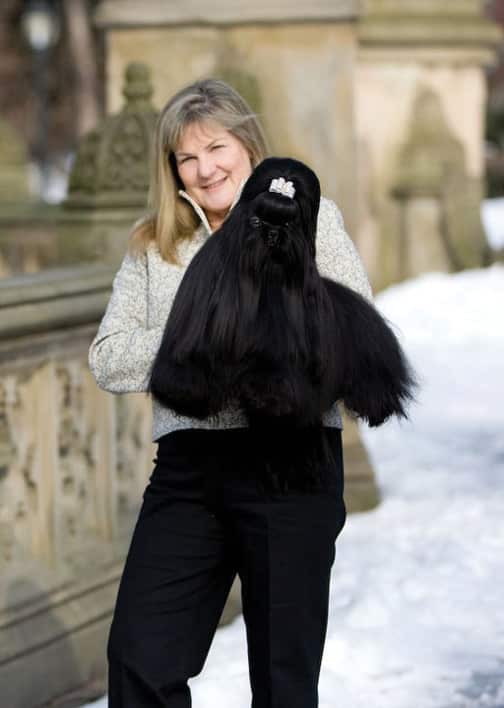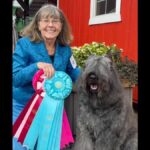Where did you grow up?
Chatterbox Shih Tzu | L. Sarah Lawrence : I grew up in Southern California on a small ranch in La Tuna Canyon. It was quiet, warm, and peaceful. I remember fields of strawberries at the front of the house and avocado groves in the back; the scent of the hay, and mornings spent watching the horses run in the pastures. As a young girl, prior to the development of the San Fernando Valley, I would ride my horse to and from school each day. My grandfather raised American Saddlebreds, while my grandmother raised show dogs.
Do you come from a doggy family? If not, how did the interest in breeding and showing purebred dogs begin?
Chatterbox Shih Tzu | L. Sarah Lawrence : By the time I was two months old, my father had joined the Air Force and my mother had permanently abandoned me at the home of my paternal grandmother, Miriam Thompson, a notable figure in the dog fancy. Living with my grandmother was pleasant until I entered school and began to demonstrate difficulty with reading. Resentful that I was forced upon her and frustrated with my learning disability, which we now know to be dyslexia, my grandmother treated me with wicked cruelty and called me “stupid” daily. Miriam was a member of the second graduating class of The University of California, Los Angeles, whereafter she became a teacher; still, she was intolerantly perplexed by my learning difficulties. It was not until after high school that my dyslexia was discovered, requiring me to retrain myself and memorize words. As a child, I was clever, physically coordinated, and adept at puzzles and problem solving. When I was five, a woman who came to purchase a dog from my grandmother noticed me playing in the yard and suggested to my grandmother that I become involved in dance. My grandfather would routinely drive me to her dance studio in Hollywood, 30 miles away.



At that time, Miriam was renowned for her winning Poodles under her kennel name, “Sun Canyon.” One day, after watching Maltese in the show ring, she commented that hers at home was better than the winner, and was thereby encouraged to prove it. For the first time, Miriam bred her Maltese bitch to a dog in the Midwest, producing two females, one of which became a Best in Show winner at nine months old. Subsequently, she phased out the Poodles to pursue Maltese exclusively. Growing up, I was always present at the dog shows and, at age seven, was thrust by my grandmother into showing her Maltese in the ring. From an early age, I was drawn to the unconditional love of dogs, and formed a deep, everlasting emotional connection to them. Although I confronted resistance and skepticism from my grandmother, I trusted my instincts, and ultimately produced a Best in Show dog from my first litter of Maltese.


As an adolescent, I loved to dance and surf. I earned a dance scholarship to a boarding school in Austria. Upon returning to California, at age 16, I suffered an accidental injury involving a skeg while surfing. It was a pivotal moment in my life. I could no longer pursue a career in dance; so, I turned to showing dogs as my future profession. The first dog I ever finished was a Japanese Chin for Kate Cross. When Jane Fitz returned with a dog from Europe, I began showing Shih Tzu as a professional handler in the Miscellaneous Class in 1968, one year prior to their AKC breed recognition. Over the years, I have finished more than 200 Maltese champions and, as a professional handler, conditioned and showed a wide variety of other coated breeds, including Lhasa Apsos, Bearded Collies, Tibetan Terriers, and Yorkshire Terriers.
Who were your mentors in the sport? Please elaborate on their influence.
Chatterbox Shih Tzu | L. Sarah Lawrence : From a young age, I wanted to know everything I possibly could about breeding, conditioning, and showing dogs. As a curious, self-motivated, active listener and observer, I would consider myself primarily self-taught. While my grandmother provided me with some access, I fervently sought out experiential learning opportunities and individuals with a willingness to share their skills, knowledge, and expertise to support my development. When Frank Sabella was showing my grandmother’s Poodles, I would assist him ringside and in his set-up at the shows. I will always remember the parallel he drew between dance and showing dogs, whereupon the exhibitor is meant to fade into the background in order to fully showcase the dog. As I was a ballet dancer, this philosophy resonated with me because you and your dog are meant to work as a unit, much like you and your partner act in concert during a performance. Working with Ric Chashoudian brought increased structure to the routine and a more geometric view of dogs; specifically, viewing them as angles, wherein their points meet in specific areas in order to create balance and fluid movement. At the time when the Shih Tzu breed first began to receive recognition, Janet Long had some of the most beautiful blacks. She taught me many facets and techniques of coat care as well as ways to understand how Shih Tzu think in order to encourage them to become show dogs. I feel fortunate to have been mentored by some of the most influential icons and pillars of the dog show world. I met my husband of 34 years, Richard Lawrence, at a dog show. Given that he bred and showed notably outstanding Yorkshire Terrier and Pekingese champions, he has always understood and respected the drive and dedication required to nurture and present beautiful dogs. Through sharing techniques, ideas, and expertise regarding training, conditioning, grooming, breeding, and showing, we have learned from one another. I would not be where I am today without his ongoing devotion
and support.

The Chatterbox Shih Tzu are widely known, highly successful and well respected. What breeding philosophies do you adhere to?
Chatterbox Shih Tzu | L. Sarah Lawrence : While many would argue the choice of the dog in breeding makes all the difference as a determining factor, it is my belief that the quality of the bitch has more dominance. I consider the value to be 60% the bitch and 40% the dog and, as such, aim to breed the best possible bitch with the most compatible dog. Seeing as I do not believe in fault offset, as it may give rise to exaggerated features, I operate from a solid base, using moderation to engender corrections within my breeding program. I consider it of the utmost importance to gain a thorough understanding of the breed standard’s requirements. I exclude any dog with an undesirable temperament from breeding, as Shih Tzu are meant to be outgoing, happy, affectionate, friendly, and trusting towards all. Also, I typically wait to breed a bitch until her third season because I want her to be mature, with a desire to nurture her own puppies. As a general rule, I will breed a bitch no more than three times in her lifespan.
How many dogs do you currently house? Tell us about your facilities and how the dogs are maintained.
Chatterbox Shih Tzu | L. Sarah Lawrence : While not a poker player, I am a firm believer in not showing all of my cards, so to speak. I rather enjoy keeping others on their toes, surprising exhibitors and breeders by walking in the ring with a dog they might not expect from me on the other end of the lead. That said, I house a broad range of dogs from my breeding program. While I may be known for my beautiful solid blacks, I have some very exciting, unexpected dogs on the horizon. In terms of my facility, the Chatterbox dogs are currently situated on a 65-acre farm in Northern Ocala, Florida. I have converted a three-bedroom house into their living space, wherein they are separated into groups of males, females, and current and emerging show dogs, with everything in each room tailored specifically to meet the individual needs of that group. I take the utmost care to ensure that the specific needs of every dog are met in that each has its own private, spacious, comfortable, and safe space to sleep and eat. Each crate is secure, appropriately ventilated, provides fresh water, and prominently displays the registered and call name; AKC number; date of birth; and sire and dam of every dog. Crates and water containers are emptied, sanitized, and disinfected daily and, afterward, each dog receives freshly laundered bedding, towels, and toys. My dogs spend most of their time exercising either in separate runs or together in sizable outdoor and indoor spaces, providing protection from adverse weather conditions. There is a full-size kitchen, housing an overflow of food in airtight containers for each dog’s special dietary needs, including food we prepare on-site to accommodate highly specific allergies. Whether they are being groomed, snuggled, or played with, each of my dogs receives individualized attention daily. My apprentice and I live in a house that is attached to theirs via a closed-in breezeway, allowing for 24-hour care and ready access in the event of an emergency. Lastly, we have created a training space where we acclimate my dogs to ring procedures, including entering the ring, table stacking, and walking down and back.


Who were/are some of your most significant Shih Tzu, both in the whelping box and in the show ring?
Chatterbox Shih Tzu | L. Sarah Lawrence : My first top-winning Shih Tzu was Ch. Wenshus Mona Lisa, bred by Donna Gerl, in the mid-1980s. For a long time thereafter, I decided to focus solely on my Maltese. One day, in 2005, I was spending time off the showgrounds with Shih Tzu breeders, Joanne and Jennifer Miller. I was captivated by one of their two four-month-old puppies. I purchased the dog right then and there. Ch. Krissy’s Dream Lover would become not only the Number One Shih Tzu in 2009, but also a foundational stud dog. Soon after, I also purchased Krissy’s Once Upon a Dream. Chatterbox Shih Tzu came to be as a result of blending the bloodlines of Jennifer and Joanne with those of Donna. Prior to 2008, I had reconnected with Donna and had been showing her dogs. Soon after, Donna presented me with Pekings Midnight Vision at Wenshu, and I immediately fell in love with her. She ultimately earned recognition as the top-winning black Shih Tzu in all of AKC history. Donna and I formed an exceptional partnership, wherein we cared very little about which of our names were listed as breeders and owners. In 2009, we bred Wenshu’s Motown Just Fabulous to Krissy’s Once Upon a Dream, resulting in Ch. Chatterbox Ella Enchanted and Ch. Chatterbox Sheza Princess. In 2010, we bred Ch. Krissy’s Dream Lover to Ch. Wenshus Shes All That Peking, producing GCHS Wenshus Shesa Dream, a bitch that would become the Number Two Shih Tzu in 2012. In 2011, I did a repeat breeding of Ch. Krissy’s Dream Lover and Wenshus Shes All That Peking that produced GCHB Chatterbox Light My Fire. In 2012, I bred Ch. Krissy’s Dream Lover to Ch. Chatterbox Ella Enchanted to produce GCH Chatterbox My Boyfriend’s Back. In 2013, I bred Ch. Krissy’s Dream Lover to Ch. Chatterbox Ella Enchanted, producing Ch. Chatterbox Wish Upon a Star. Also in 2013, Donna and I bred Ch. Krissy’s Dream Lover to GCH Pekings Midnight Vision at Wenshu, which
produced GCH Wenshu Leaving Me Breathless and GCHS Wenshu In The Midnight Hour, the only black Shih Tzu National Specialty winner. In August of 2014, I was honored by the Santa Barbara Kennel Club and Purina Pro Plan in conjunction with the Breeder’s Showcase as an outstanding breeder and contributor to the sport of dogs, especially in the Toy Group. In 2015, I bred Chatterbox Comin’ Up BlackJack to Ch. Chatterbox Sheza Princess to produce Ch. Chatterbox Blame It On The Sun, awarded Best Puppy at the National Specialty and Winners Dog at the American Shih Tzu Club (A.S.T.C.) Regional Specialty in 2016. In April of 2017, I received the Wenrick Good Sportsmanship Award at the A.S.T.C. National Specialty.


The sport has changed greatly since you first began exhibiting. What are your thoughts on the state of the fancy and the declining number of breeders? How do we encourage newcomers to join us and remain in the sport?
Chatterbox Shih Tzu | L. Sarah Lawrence : In some ways, this is a controversial question. Nowadays, a large majority of the public believes all breeders are cruel and irresponsible for contributing to an overpopulation crisis. People for the Ethical Treatment of Animals (PETA), for example, emphatically maintains there is no such thing as a responsible breeder. Their claims that all dogs suffer harmful
consequences as a result of human manipulation and that every time someone purchases a dog, rather than adopts from a shelter, homeless animals lose their chance of finding a home and will be euthanatized, ultimately disgraces the sport and serves to alienate potential newcomers. The dissemination of these limited, extremist views regrettably generates a negative reputation, overshadowing all those ethical and reputable breeders dedicated to specialized and selective breeding as well as breed preservation. I believe it is vital for breeders to continually educate the public with regard to the benefits, importance, and necessity of responsible dog breeding. Additionally, in an ever-changing world, rife with potential activities and opportunities, it has become more difficult to maintain the attention and commitment that is required of the dog fancy. Also, in certain regions, breeding regulations have become excessively stringent, and the cost of care and entry fees have increased substantially. More specifically, Shih Tzu are high-maintenance dogs and it is a challenge to find people who are truly dedicated to their proper presentation. The physical and mental conditioning of a show dog requires passion, skill, and considerable patience. It is the responsibility of long-term breeders to encourage newcomers and instruct them on proper care for dogs and
showing practices.
Where do you see your breeding program in the next decade or two?
Chatterbox Shih Tzu | L. Sarah Lawrence : Ideally, my hope would be to take after revered breeder and judge Kathleen Kolbert, who remains dedicated to outstanding breed type and consistency. I admire her legacy, holding her in high regard, as I am inspired by her commitment to her breed standard’s requirements and her love of the sport. As always, I look forward to seeing her at all of the big shows and hope to follow in her footsteps. To help ensure the continuation of my breeding program, I have been working with an apprentice, Rebecca Batty. For the past six years, her deep affection for the dogs, dedication to the sport, and immeasurable contribution have proven invaluable.
Finally, tell us a little about Sarah outside of dogs… your profession, your hobbies.
Chatterbox Shih Tzu | L. Sarah Lawrence : Showing dogs is my profession. Training, cleaning, grooming, and caring for my dogs and maintaining their condition requires a great deal of my time and attention. I delight in traveling, especially to California and abroad, whether for showing or leisure. I love the ocean and deep-sea fishing. I enjoy fine dining, and audio books by James Patterson. My favorite way to relax is by watching British television with themes of action, romance, drama, and mystery. I frequently visit with my daughter, her husband, and their close group of friends, who have become like my children.




















